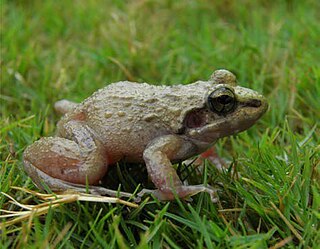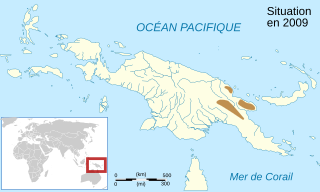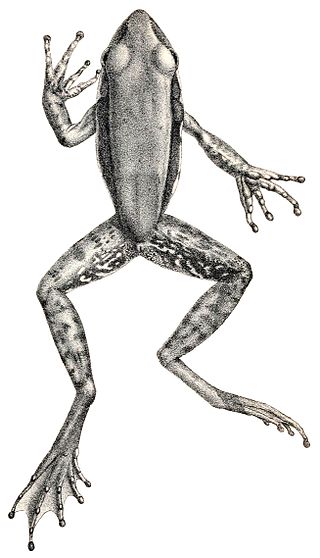
Indirana leithii is a species of frog in the family Ranixalidae. It is endemic to the northern Western Ghats of India. As currently defined, its range is restricted to the states of Maharashtra and southern Gujarat; earlier records elsewhere refer to other species.
Dendropsophus aperomeus is a species of frog in the family Hylidae. It is endemic to Peru and occurs on the Amazonian slopes of the Andes in northern and central Peru. Common name Balzapata treefrog has been coined for it.

Dryaderces inframaculata is a species of frog in the family Hylidae. It is endemic to Brazil and known from between the Tapajós and Xingu Rivers in Pará. Until recently, it was only known from one specimen collected near Santarém, probably around 1876, by Henry Wickham. Common name Santarem treefrog has been coined for it.
Callimedusa duellmani is a species of frog in the subfamily Phyllomedusinae. It is endemic to Peru and is only known from its type locality near Balzapata, upper Chiriaco River, in the Department of Amazonas. The specific name duellmani honors William E. Duellman, an American herpetologist. Common name purple and orange leaf frog has been proposed for it.

Ptychohyla zophodes is a species of frogs in the family Hylidae. It is endemic to Mexico and known from the Atlantic slopes of the Sierra Madre de Oaxaca in northern Oaxaca and adjacent central-western Veracruz. Before being described as a new species in 2000, it was mixed with Ptychohyla leonhardschultzei. The specific name zophodes is a Greek word meaning "dusky" or "gloomy" and refers to the distinctive dark coloration of the species as well as its cloud forest habitat. Common name gloomy mountain stream frog has been coined for it.
Craugastor trachydermus is a species of frog in the family Craugastoridae. It is endemic to Guatemala and only known from its type locality, Xiacam in the Sierra de Santa Cruz, Izabal Department, where the type series was collected in 1989. The species might already be extinct. However, specimens collected some 10 km (6.2 mi) from the type locality might belong to this species.
Pristimantis maculosus is a species of frog in the family Strabomantidae. It is endemic to Colombia and is only known from a few localities in the Cordillera Central in Caldas, Antioquia, and Quindío Departments. The specific name maculosus is Latin for "dappled" or "spotted" and refers to the pale spots on the hidden surfaces of this species. Common name spotted robber frog has been coined for it.
Pristimantis polemistes is a species of frogs in the family Strabomantidae. It is endemic to Colombia and only known from the vicinity of its type locality in Urrao, Antioquia Department, on the western flank of the Cordillera Occidental. The specific name polemistes is Greek for "warrior" and refers to the insurgents that operated in the area of the type locality.
Cophixalus nubicola is a species of frog in the family Microhylidae. It is endemic to Papua New Guinea and only known from its type locality, Mount Michael in the Eastern Highlands Province. The specific name nubicola refers to its cloud-swept habitat. Common name Michael rainforest frog has been coined for this species.
Cophixalus riparius is a species of frog in the family Microhylidae. It is endemic to Papua New Guinea and occurs in the New Guinea Highlands in Madang, Southern Highlands, and Western Highlands provinces southeastward to the Morobe Province. The specific name riparius refers to the creek-side habitat from which many specimens in the type series were collected. Common name Wilhelm rainforest frog has been coined for this species.

Cophixalus shellyi is a species of frog in the family Microhylidae. It is endemic to Papua New Guinea and occurs in the New Guinea Highlands as well as in the Adelbert Range and on the Huon Peninsula. The specific name shellyi honors Father Otto Schellenberger ("Shelly"), an American missionary and former professor in mathematics who collected the type series.

Petropedetes johnstoni is a species of frog in the family Petropedetidae. It is endemic to coastal Cameroon and known with certainty only from few localities. For a period, Petropedetes newtonii was considered a junior synonym of this species, leading to a much broader distribution. The two species are now considered distinct, but information on Petropedetes johnstonisensu stricto is limited. Common name Johnston's water frog has been coined for this species.

Phrynobatrachus minutus is a species of frog in the family Phrynobatrachidae. It is endemic to Ethiopia and occurs in the central and southern parts of the country on both sides of the Rift Valley; its range may extend south to Kenya, perhaps further. Some earlier records from Ethiopia represent Phrynobatrachus inexpectatus, described as a new species in 2001. The specific name minutus refers to the small size of this frog. Common names tiny river frog and Ethiopian dwarf puddle frog have been coined for it.
Phrynobatrachus ogoensis is a species of frog in the family Phrynobatrachidae. It is endemic to Gabon and is known from its type locality, Lambaréné in the Moyen-Ogooué Province and from the Ramba Village in the Ogooué-Ivindo Province, in the buffer zone of the Lopé National Park.
Meristogenys whiteheadi is a species of frog in the family Ranidae. It is endemic to Borneo and found in both Indonesia (Kalimantan) and Malaysia. Meristogenys stigmachilus and Meristogenys stenocephalus, described as new species in 2011, were formerly included in this species. Owing to the difficulty of distinguishing these species under field conditions, the exact range of this species is uncertain. Its common name is Whitehead's Borneo frog or Whitehead's torrent frog.

Raorchestes parvulus is a species of frog in the family Rhacophoridae. It is found from eastern Bangladesh east through Myanmar and Thailand to Cambodia, northern Vietnam, Laos, and Peninsular Malaysia. Its distribution might well extend into northeastern India and southern China. This species was first described by George Albert Boulenger based on seven specimens collected by Leonardo Fea from Karen Hills, Burma.
Theloderma phrynoderma is a species of frog in the family Rhacophoridae. It is endemic to Myanmar and known from two widely separated localities: Thao, its type locality in the Karen Hills in south-central Myanmar where it was collected by Leonardo Fea in 1888, and the Tanintharyi Nature Reserve in southern Myanmar near the Thai border where it was collected in 2009–2010. Common name Burmese bug-eyed frog has been coined for it.
Papurana attigua is a species of frog in the family Ranidae, the "true frogs". It is found in central and south Vietnam, eastern Cambodia, and southern Laos. The specific name attigua is derived from Latin attiguus meaning "neighbor". It refers to the similarity of this species to Indosylvirana milleti. The common name similar frog has been coined for this species.

Papurana kreffti is a species of true frog, family Ranidae. It is native to New Ireland and Buka Island and the Solomon Islands. The specific name kreffti honours Gerard Krefft, a German adventurer who settled in Australia and became there to be regarded as the father of Australian herpetology. Common names San Cristoval frog and San Cristobal treefrog have been coined for it.

Callulops omnistriatus is a species of frog in the family Microhylidae. It is endemic to Papua New Guinea and is known from the southern slope of the Central Highlands, Southern Highlands Province. The type locality is in the vicinity of the Moro Airport.










